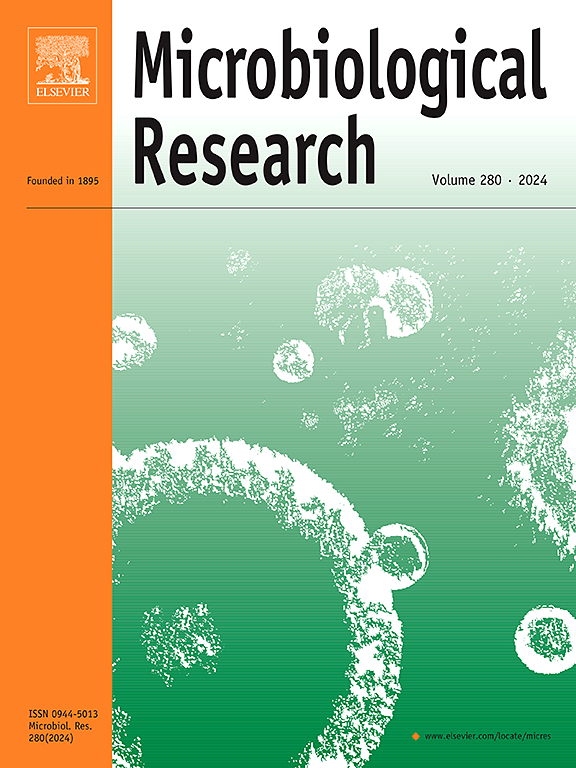Understanding the ternary interaction of crop plants, fungal pathogens, and rhizobacteria in response to global warming
IF 6.1
1区 生物学
Q1 MICROBIOLOGY
引用次数: 0
Abstract
Climate change is altering the equilibrium of the Earth’s biosphere, imposing unpredictable survival dynamics on terrestrial organisms. This includes the intricate interactions between fungal pathogens and crop plants, which are pivotal for global food security. Rising temperatures are expected to exacerbate the prevalence of crop-pathogenic fungi worldwide, yet research on how crops respond to this imminent threat remains limited. Here, we identified predominant potential pathogens and antagonistic bacteria in vegetable fields in Shandong Province, China, revealing the near-ubiquitous presence of Fusarium oxysporum and Bacillus species in sampled soils of cucumber, tomato, chili, and ginger. Through simulated warming experiments within a temperature range of 20–40 °C and an experimental period of 3 days, we investigated the ternary interaction among vegetables and isolated F. oxysporum strain 05, and Bacillus sp. strain 31. Elevated temperatures enhanced F. oxysporum biomass and virulence, yet also stimulated vegetables to allocate more nutrients via root exudates. This enriched rhizospheric antagonistic Bacillus populations, it also boosted the expression of antifungal lipopeptide biosynthetic genes (bamb and ItuA) and auxin production in Bacillus sp. strain 31. This enrichment promoted plant growth and maintained a relatively stable level of pathogenic fungi. Our study unveiled a nuanced and complex interplay among crop plants, fungal pathogens, and rhizobacteria, that could inform future agricultural practices, and advance our understanding of crop survival strategies to bolster crop resilience and safeguard global food security under ongoing climate change.
了解农作物、真菌病原体和根瘤菌对全球变暖的三元相互作用
气候变化正在改变地球生物圈的平衡,对陆地生物施加不可预测的生存动态。这包括真菌病原体与作物之间复杂的相互作用,这对全球粮食安全至关重要。气温上升预计将加剧全球作物致病真菌的流行,但关于作物如何应对这一迫在眉睫的威胁的研究仍然有限。在这里,我们鉴定了中国山东省菜地中主要的潜在病原体和拮抗细菌,揭示了黄瓜、番茄、辣椒和生姜取样土壤中几乎无处不在的尖孢镰刀菌和芽孢杆菌。通过20 ~ 40℃的模拟增温实验和3 d的模拟增温实验,研究了蔬菜与分离的尖孢镰刀菌05和芽孢杆菌31的三元互作关系。升高的温度增加了尖孢镰刀菌的生物量和毒力,但也刺激了蔬菜通过根分泌物分配更多的营养。这丰富了根际拮抗芽孢杆菌种群,也促进了抗真菌脂肽生物合成基因(bamb和ItuA)的表达和菌株31生长素的产生。这种富集促进了植物生长,并保持了相对稳定的致病真菌水平。我们的研究揭示了作物、真菌病原体和根瘤菌之间微妙而复杂的相互作用,这可能为未来的农业实践提供信息,并促进我们对作物生存策略的理解,以增强作物的适应力,并在持续的气候变化下保障全球粮食安全。
本文章由计算机程序翻译,如有差异,请以英文原文为准。
求助全文
约1分钟内获得全文
求助全文
来源期刊

Microbiological research
生物-微生物学
CiteScore
10.90
自引率
6.00%
发文量
249
审稿时长
29 days
期刊介绍:
Microbiological Research is devoted to publishing reports on prokaryotic and eukaryotic microorganisms such as yeasts, fungi, bacteria, archaea, and protozoa. Research on interactions between pathogenic microorganisms and their environment or hosts are also covered.
 求助内容:
求助内容: 应助结果提醒方式:
应助结果提醒方式:


